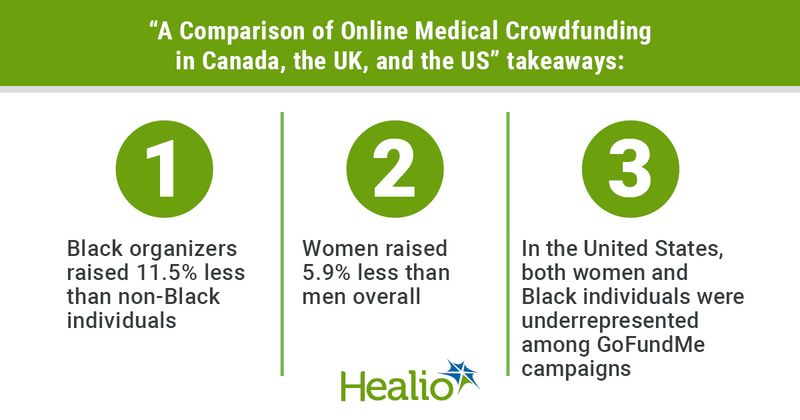Medical crowdfunding less successful for Black, female organizers
Black individuals organizing medical crowdfunding campaigns in the United States, the United Kingdom and Canada raised 11.5% less than non-Black individuals, and women raised 5.9% less than men, according to data published in JAMA Network Open.
The researchers also found that crowdfunding campaigns to cover routine care expenses were approximately 3 times more common in the U.S. than in Canada or the U.K., and less likely to succeed compared with campaigns for experimental and approved but inaccessible therapies.

“Approximately one-third of all crowdfunding campaigns seek public monetary donations intended to pay for health care-related costs,” Sameh N. Saleh, MD, of the University of Texas Southwestern Medical Center, and colleagues wrote. “The growing importance of medical crowdfunding (MCF) is reflected by trends on GoFundMe, the largest social crowdfunding platform in the world. In 2011, medical causes raised $1.6 million on GoFundMe; in 2014, the amount had increased almost a hundredfold to $150 million and in 2016, more than $650 million.”
“The growing reliance of health care consumers from the U.S. on MCF has been attributed to increasing health care costs and the lack of a publicly funded health care system,” they added. “However, the popularity of MCF in developed countries with universal health care such as Canada and the UK cannot be similarly explained. To date, MCF has financed a range of therapies, including experimental and alternative therapies. However, inequity, barriers to access, invasion of privacy, fraud and dangerous, unproven therapies have been associated with MCF, but are poorly understood.”
To analyze the demographics of medical crowdfunding organizers, as well as campaign characteristics, and their association with funding success in the United States, Canada and the United Kingdom, Saleh and colleagues conducted a cross-sectional study of data from GoFundMe campaigns launched between February 2018 and March 2019. All available campaigns within each country domain’s medical discovery page on GoFundMe that benefitted a unique individual were included.
In all, the researchers analyzed 3,396 campaigns — 1,091 from Canada, 1,082 in the United Kingdom and 1,223 based in the United States. These campaigns collectively raised $92.9 million, or 51.9% of the total funds sought. Exposures included campaign and beneficiary characteristics, and the primary outcome was the log-transformed amount of funds raised in U.S. dollars. Data analysis began in March 2019 and was completed that December.
According to the researchers, campaigns in the United States (median IQR = $38,204; 95% CI, $31,200-$52,123) raised more funds than those in Canada ($12,662; 95% CI, $9,377-$19,251) and the United Kingdom ($6,285; 95% CI, $4,028-$12,348).
In the overall cohort per campaign, Black organizers raised 11.5% less (95% CI, –19% to –3.2%) than non-Black individuals. In addition, men raised 5.9% more (95% CI, 2.2% to 9.7%) than women overall. In the United States, both women and Black individuals were underrepresented among GoFundMe campaigns. Women had organized 39.4% of included campaigns, compared to their 50.8% share of the U.S. population (difference = 11.3%; 95% CI, 8.6% to 14.1%), and although Black individuals make up 13.4% of the total population, just 5.3% of campaigns were organized by Black beneficiaries (difference = 8.1%; 95% CI, 6.8% to 9.3%).
Approximately one-third of all campaigns — 1,078 in total — were aimed primarily at covering treatment expenses. Among these, campaigns to fund routine care were approximately 3 times more common in the United States, with 77.9% of 349 campaigns, than in Canada, with 21.9% of 251 campaigns (difference = 56%; 95% CI, 49.3% to 62.7%), or the United Kingdom, with 26.6% of 478 campaigns (difference = 51.4%; 95% CI, 45.5% to 57.3%).
However, campaigns for routine care were less successful overall. For example, approved, inaccessible care raised 35.7% (95% CI, 25.6% to 46.7%) more per campaign than routine care, while experimental care campaigns raised 20.9% (95% CI, 13.3% to 29.1%) more.
Campaigns primarily for alternative treatment expenses were nearly four-fold more common for cancer — 23.5% of 614 campaigns — compared with noncancer — 6.5% of 465 campaigns — diagnoses.
“MCF directly (through platforms that promote the victim narrative) and indirectly (by rewarding these narratives with funding success) promotes the myth that gaps in health care funding are due to misfortune and exceptionality, rather than systemic failures,” Saleh and colleagues wrote. “As such, MCF may entrench the systemic failures that led to its need. Thus, although crowdfunding has the potential to provide short-term relief from medical financial burden for a subset of patients, it may carry wider-reaching paradoxical societal effect for those most socially disadvantaged.”

